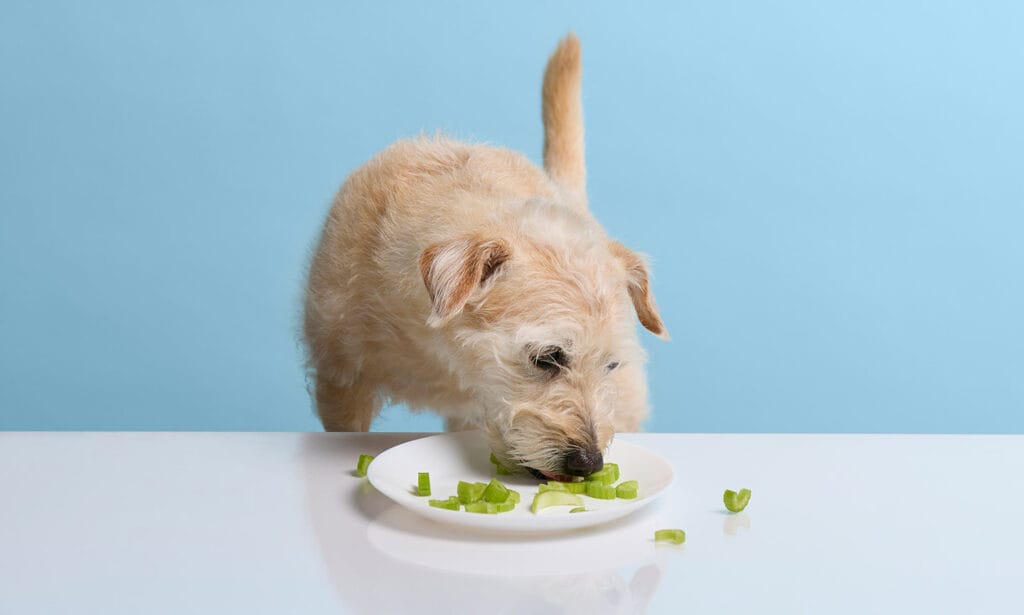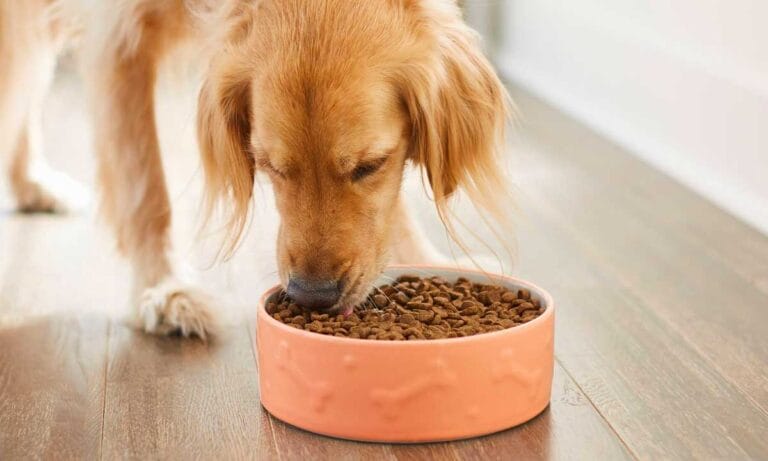If you’re looking for healthy treats to add to your dog’s diet, try vegetables for dogs. Not only are vegetables a good source of vitamins and minerals that provide health benefits, but non-starchy dog-friendly vegetables are also low in calories and fat. Wondering what vegetables can dogs eat? Well, listen up!
With the help of some experts, we found the best vegetables for dogs. From carrots to zucchini, these veggies for dogs are healthy and delicious! And to help you out in the kitchen, we also learned how to prepare vegetables for dogs.
Can dogs eat raw vegetables? Yes! But there are many other ways to prep veggies for dogs. You can cook, steam, bake, roast, grill or puree these dog-friendly vegetables. But no matter how you prepare vegetables for dogs, avoid using salt! Dogs don’t always care for it and, even on the best vegetables for dogs, it is not good them.
Read below to see what vegetables can dogs eat and how to prepare vegetables for dogs, with suggested portion sizes for treats. Bon appetit!
Dog-Friendly Veggies
Click on a vegetable to learn more.
Asparagus

Benefits:
- Good source of vitamins A, B1, B2, E and K, folate, iron copper, fiber, manganese and potassium
- Contains vitamin C, an immune-system booster
- High in essential minerals and nutrients
- Zero fat, high in fiber
Preparation:
- Remove the fibrous ends from the asparagus spears and wash them thoroughly.
- Toss them with olive oil and grill 30 to 60 seconds on all sides, until tender.
- Cut into bite-size pieces.
Broccoli

Benefits:
- High in vitamin C, A and B, as well as calcium, phosphorus, zinc, and other minerals.
- Rich in vitamin K which can help with bone density
- High in fiber, zero fat, low calories
Preparation:
- Cut broccoli into small florets and wash thoroughly.
- Using a stove, put florets in an open vegetable steamer in a pot with boiling water and cover.
- Steam for about 6 to 8 minutes until crisp yet tender and bright green.
- You can also microwave them by putting 2 cups of broccoli florets in a microwave-safe container along with an inch of water for about 5 minutes.
- No added spices or seasonings (keep it simple and steam). Broccoli cooked with onions or garlic is to be strictly avoided (sorry, no leftover Chinese!).
- Cut into bite-size pieces.
Brussels Sprouts
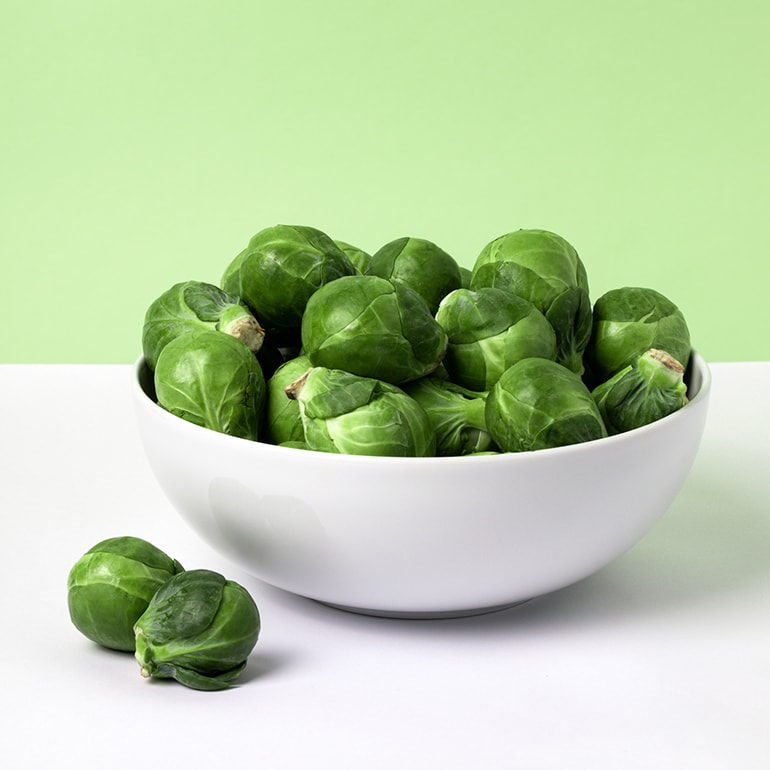
Benefits:
- Great source of vitamins C and K (good for immune system and bone density, respectively)
- Good source of manganese, folate, fiber, potassium and vitamins A, B1 and B6
Preparation:
- Choose Brussels sprouts that are green, feel firm and don’t smell too strong.
- Do not add spices or seasonings.
- Wash thoroughly and cut off the stems, leaving enough stem that the leaves are still intact. Some chefs advise cutting a little X to in the stem to help the core to cook.
- You can then microwave the sprouts with water for up to 8 minutes, steam them for 5 minutes or boil the sprouts for up to 10 minutes—a little less for more crunchiness.
- Serve sprouts cooked and sliced with tough ends trimmed.
Dog treat portion size:
- Half to two sprouts, depending upon the dog’s size.
- Brussel sprouts can make dogs gassy, so serve in moderation until you observe tolerance to this food.
Carrots

Benefits:
- High in vitamins, essential nutrients and minerals
- Contains beta carotene, which is converted into vitamin A
- Good source of vitamins K and C, fiber and potassium
- Crunchy and sweet, most dogs love carrots.
- Grated carrots are an excellent nutrition-rich topper for prepared dog foods.
Preparation:
- Remove ends and thoroughly wash.
- If buying organic carrots peeling is not necessary; conventionally grown carrots should be peeled.
- Cut into bite-size treats and cook in a pot of boiling water for about 10 minutes or steam for two to six minutes until tender.
- Can be eaten raw or cooked.
- Can be a choking hazard; cut into bite-sized pieces.
Cauliflower

Benefits:
- Great source of vitamin C
- Good source of vitamins K and B6, folate and choline
- High in fiber, zero fat, low calories
Preparation:
- Wash thoroughly. To grill the cauliflower, leave a little stalk intact.
- Marinate the cauliflower for 30 minutes in olive oil. No added spices or seasonings (keep it simple and steam or grill). Cauliflower cooked with onions or garlic is to be strictly avoided.
- Grill for 5 to 6 minutes on each side until crisp yet tender.
Dog treat portion size:
- 1 to 2 florets, depending on the dog’s size; or 1/4 cup mashed or pureed
- Can make dogs gassy, so serve in moderation until you observe tolerance to this food.
Celery

Benefits:
- Contains vitamins A, B and C
- Nutrient-dense, low-calorie and (about 6 calories in a single stalk) water-dense (which means it’s a hydrating treat!)
- May help to freshen breath!
Preparation:
- Wash thoroughly and serve raw.
- Cut the veggie into bite-sized bits first, so they don't become a choking hazard.
- Can be served cooked, raw or even juiced and poured over prepared dog food as a treat
Dog treat portion size:
- One or two bite-size pieces
- Can cause digestive upset, so start with a small serving and observe tolerance to this food
Cucumber

Benefits:
- Rich in vitamin C, essential nutrients and some minerals
- Good source of vitamin K
- High water content makes them excellent for hydration
- Zero fat, low in calories, low in sodium
Preparation:
- Wash thoroughly, peel, cut in half and remove seeds.
- Cut into bite-size pieces.
- Cucumbers are best served raw, peeled with seeds removed, but can be cooked by placing pieces into pot with boiling water for about 5 minutes. Empty pot into strainer.
Dog treat portion size:
- One to two bite-size pieces
- Can cause digestive upset, so start with a small serving and observe tolerance to this food
Edamame
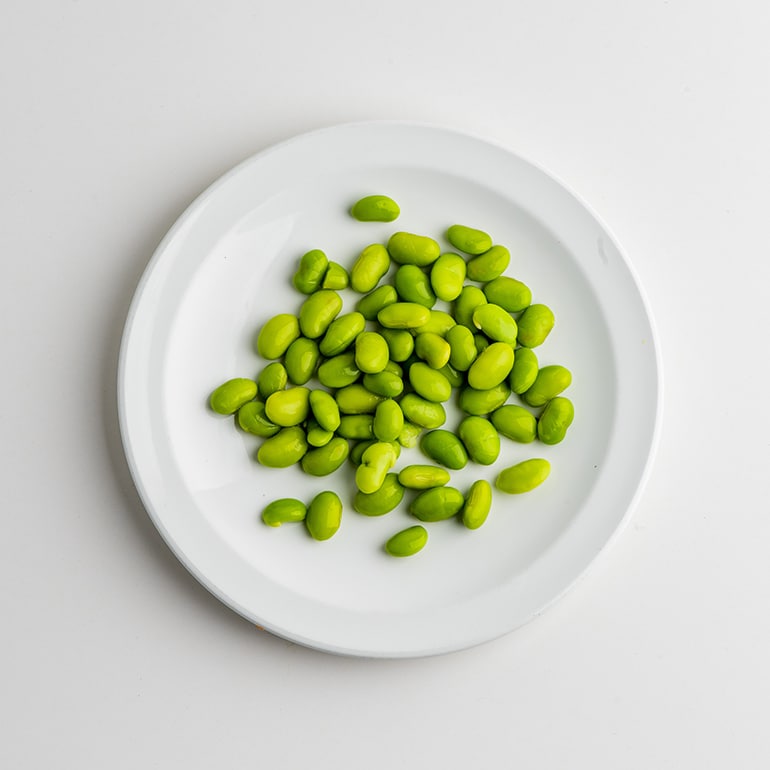
Benefits:
- Great source of protein, iron, fiber, vitamin K, Omega-3 fats, phosphorus, vitamin B2, potassium, copper and magnesium.
- High in vitamins, essential nutrients, and minerals
- High in fiber, zero fat, low in calories
Preparation:
- Steam or microwave according to the directions on the bag.
- Do not serve tough outer shell; remove beans from shells.
- No added spices or seasoning.
Dog treat portion size:
- One to five unsalted, out-of-shell beans, depending on size of dog
- Always watch your dog eat small food items as they could choke on them in their excitement to gobble them down.
Green Beans

Benefits:
- Great source of vitamins C, K and A, manganese and fiber
- High in fiber, zero fat, low in calories
Preparation:
- Serve cooked or raw.
- Wash thoroughly and cut off ends.
- Use a covered pot to cook green beans in boiling water for about 10 minutes. Serve when cool.
- You can also cook green beans, brown rice and chicken in chicken broth to serve dogs with an upset tummy.
- No added spices or seasonings; frozen or even canned is fine as long as there is no added salt, onions or garlic.
Dog treat portion size:
- One or two pieces or 1/4-cup pureed
Peas

Benefits:
- Good source of protein and fiber
- Zero fat, low in calories
- Good source of manganese, fiber, folate, phosphorus, protein, magnesium, copper, iron, zinc, potassium and vitamins B1, A, B6, B3, B2, C and K
Preparation:
- Fresh peas are usually available as snow, sugar snap or English peas.
- Snow and sugar snap peas’ shells are edible. You can grill sugar snap and snow peas for about 3 minutes on each side, first lightly coating with olive oil if you prefer.
- For English peas, you need to shell them first. Cook the peas (minus their pods) in boiling water 2 to 4 minutes until they turn bright green. Drain in a colander.
- No added spices or seasonings; frozen or canned are fine as long as there is no added salt, butter, onions or garlic.
Dog treat portion size:
- One or two sugar snap or snow peas; or 1 or 2 tablespoons of English peas, depending on the dog’s size
- Don’t feed peas to dogs with kidney issues.
Potatoes
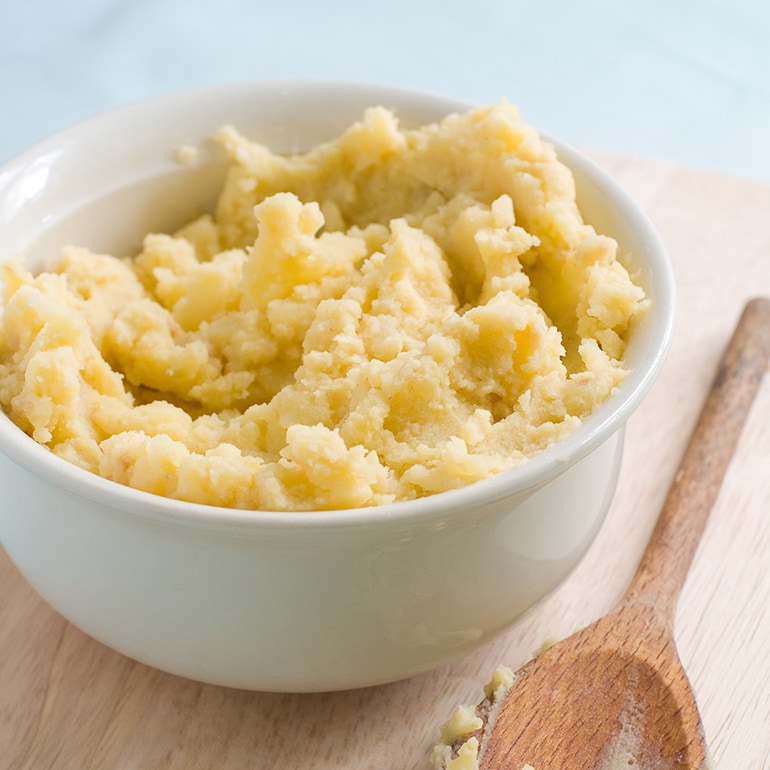
Benefits:
- Good source of vitamins C and B6, potassium, manganese and fiber
Preparation:
- Potatoes should be peeled and well-cooked; never feed your dog raw potatoes as they contain solanine, which is toxic to dogs.
- Wash thoroughly, and steam or boil; then, mash or cut into wedges and bake in the oven at 325 degrees on parchment paper.
- No added oil or salt.
- French fries, potato chips and mashed with butter or gravy are off the menu.
Dog treat portion size:
- One or two wedges or about 1/4 cup mashed, depending on dog’s size
Sweet Potatoes
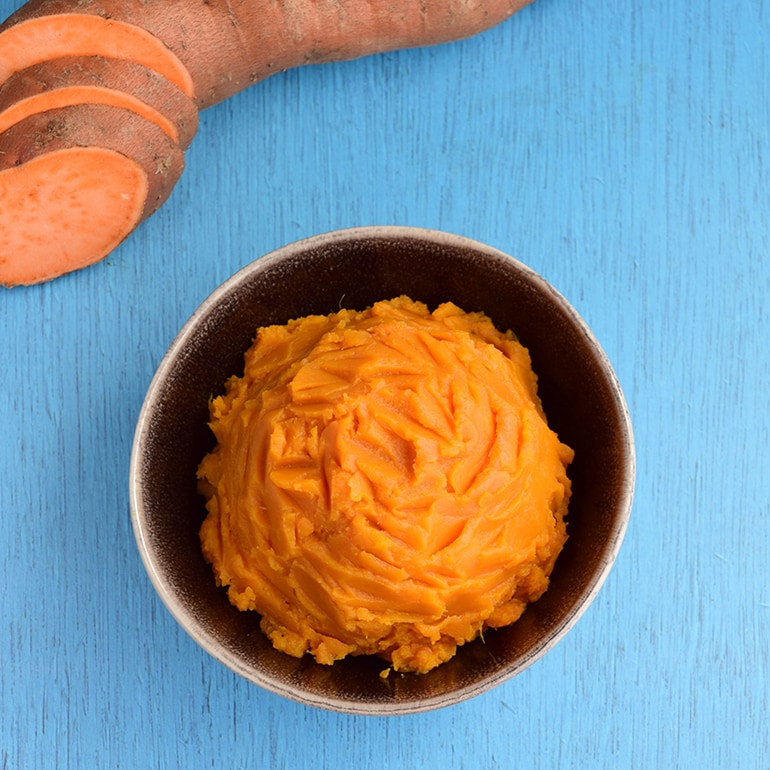
Benefits:
- Great source of vitamin A. Good source of vitamins C, B6 and B5, manganese, potassium and fiber.
- High in fiber, low in fat, excellent for constipation
Preparation:
- For a great chew, dehydrate them: Cut them lengthwise, 1/4-inch thick. Follow the vegetable dehydration instructions included with your dehydrator.
- For mashed sweet potatoes: Peel and wash potatoes. Cut into quarters. Put into boiling water in a large pot and simmer for about 20 minutes. Test potatoes with a fork. When they are fully tender, remove from pot, place in a heat-resistant container and mash with a potato masher.
Dog treat portion size:
- Dehydrated chew: 1/2 or 1 chew, depending on size of dog.
- Mashed sweet potato: 1 to 2 tablespoons (trying mixing in your dog’s dry dog food!)
- Higher in calories than other vegetables, so watch portion size
Zucchini

Benefits:
- Contains lots of vitamin C, an antioxidant and potassium, which aids in muscle and nerve health
- High in minerals and antioxidants
- Low in calories and cholesterol
Preparation:
- Can be served cooked or raw
- Do not add spices, or seasonings such as salt
- Shred it or cut it into small pieces and feed raw; or you can boil and mash and mix it in wet or dry dog food.
Dog treat portion size:
- One or two wedges or slices, or 1 to 2 tablespoons mixed in with dog food
- Can make dogs gassy; serve in moderation until you observe tolerance to this food
Vegetables Dogs Should Never, Ever Eat

Remember, there are some vegetables you should not feed to your dog, as they are toxic to dogs and can result in harmful effects. Never offer your dog the following toxic vegetables:
- Onions
- Rhubarb
- Avocado
- Wild mushrooms
- Garlic
- Unripe tomatoes and tomato plants
As a rule of thumb, always get the OK from your veterinarian before feeding your pet a new food. Even some otherwise good veggies for dogs might not be ideal for pets with certain underlying medical conditions or special dietary needs. Watch out for any adverse reactions, such as nausea or loose stools. Sometimes certain safe veggies for dogs, like Brussel sprouts, will cause gas in dogs, so don’t overdo the amount you give them.
If you are giving your pup a dog-friendly vegetable for the first time, offer just one small piece and watch them for any adverse reactions such as vomiting, diarrhea or gas before increasing the size or amount.
Frequently Asked Questions
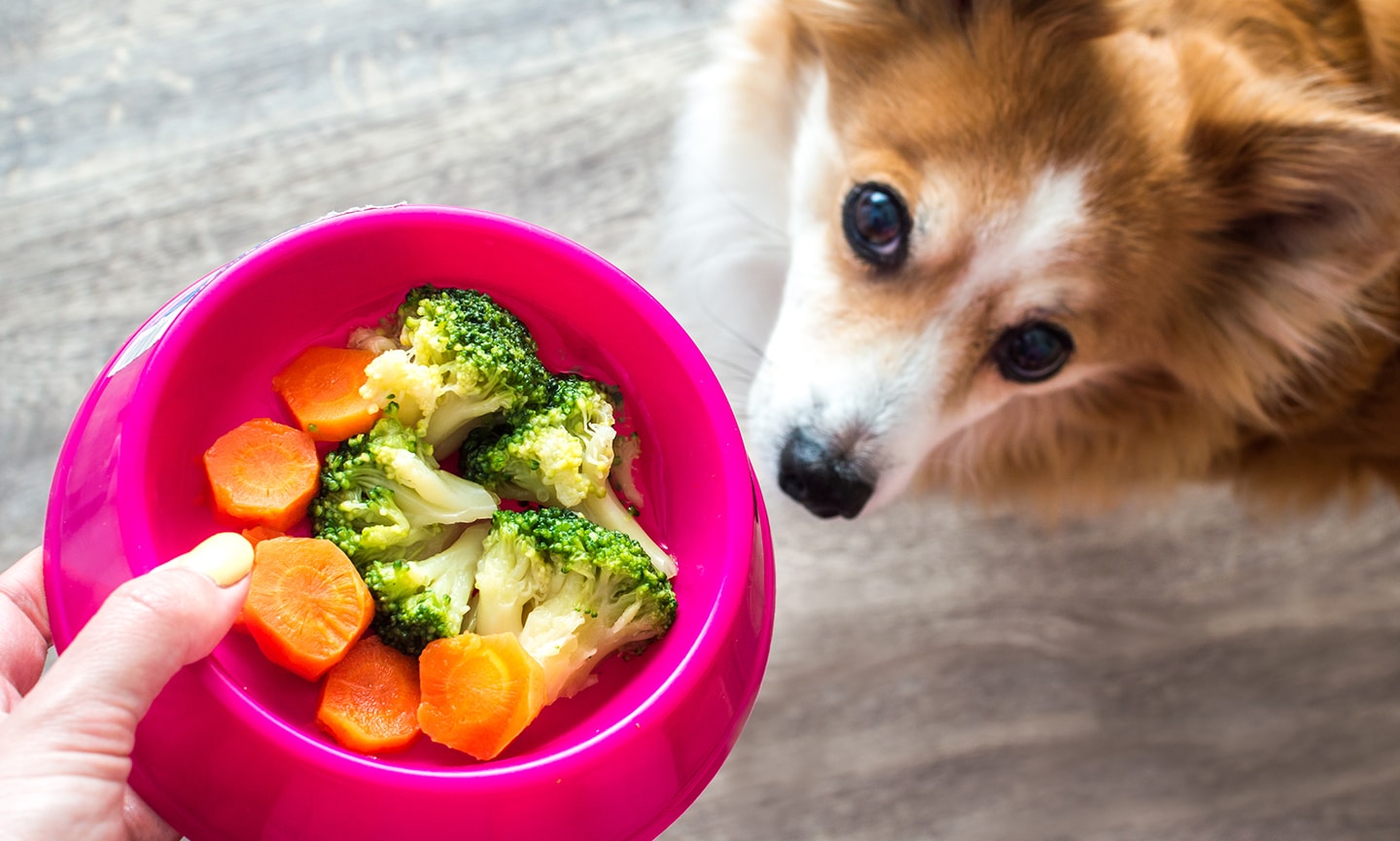
Q: What vegetables are toxic for dogs?
A: As explained above, there are several veggies that are toxic to dogs. These include onions, rhubarb, avocado, mushrooms, garlic, and unripe tomatoes and tomato plants. Be sure that these and other dangerous foods and items for dogs are always out of reach of your pooch.
Q: What vegetables are good for dogs with sensitive stomachs?
A: All pet parents should talk to their vet before giving their dog a new food—but especially if their dog has a sensitive stomach. With your vet's OK, consider peeled and mashed sweet potatoes, which are yummy and typically gentler on tummies.
Q: What are the best vegetables for puppies?
A: Puppies have sensitive tummies and very specific nutritional needs, so give your vet a call before giving them a new food—veggies included! With their OK, try very small (puppy-sized!) bits of carrots and green beans. Avoid highly fibrous vegetables like broccoli.
Q: Can dogs eat the skin of vegetables?
A: Dogs can consume the skin of many vegetables. Follow the preparation instructions above to best ensure your dog's safety.
There are no “stupid” questions when it comes to your pet’s health. If you suspect your pet is sick, please call your vet immediately. For diet, wellness and health-related questions, always consult your regular veterinarian when possible as they can make the best recommendations for your pet. (If you need help finding a vet near you use this link.) The content on this blog is provided for informational use only and does not constitute professional veterinary advice, diagnosis or treatment.
More foods dogs can eat:
Share:
